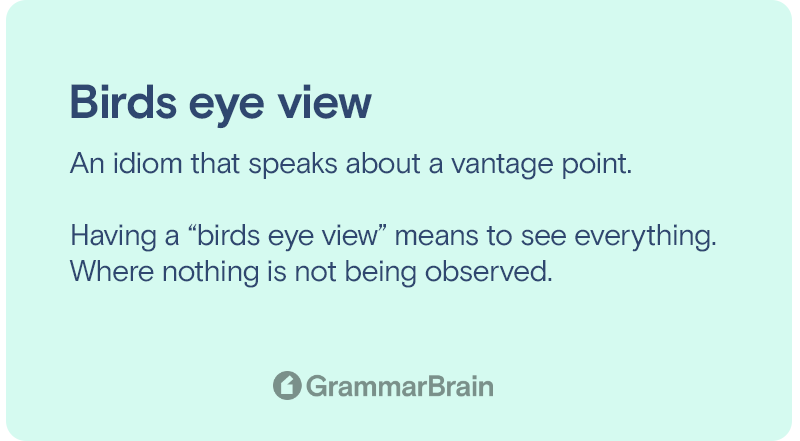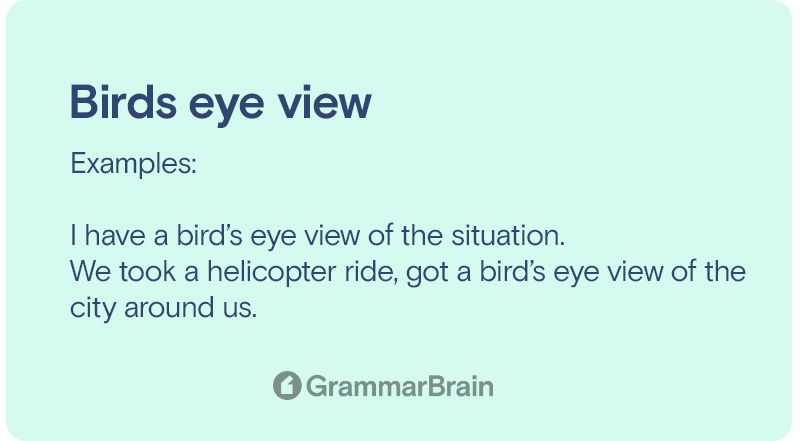Bird’s eye view is an idiom commonly used to describe a situation where you need to take a look at the bigger picture and can connect the links in detail. A bird flies high up in the sky so it can see the things going on from the upper and get detailed information that others can not see.
What Type of Term is “Birds Eye View?”
The term bird’s eye view is an idiom. An idiom is an indivisible phrase characteristic of a given language whose meaning does not follow the meanings of its constituent components. It is also a phraseological unit, and it is also a stable expression.
Using the idiom bird’s eye view, the narrator wants to explain a situation without any gaps, like a bird watches everything from high in the sky.

What is the Meaning of the Idiom “Bird’s Eye View?”
A bird’s eye view is a view of an object viewed from above. It is as if the bird is looking at an object, hence the name. A bird’s-eye perspective can make the viewer feel like they’re protecting the object underneath.
The sights through the eyes of a bird are clear. You can see very small details and connections if you see the view from a bird’s eye. Like birds see the world in how it looks for food, indicating that nothing can be hidden from a bird’s eye.
The phrase “bird’s eye view” has been used literally and figuratively since about 1600. The idiom alludes to observing situations as literal birds would. People used it to describe a complete aerial perspective before airplanes became widely used. It’s possible that cartographers, navigators, and other specialists commonly used this phrase to describe impenetrable or ethereal viewpoints.
Examples of Using the Term “Bird’s Eye View”
The idiom “Bird’s Eye View” can describe various situations.
Situation 1: Seen From Above:
When the plane began to descend, we saw Cleveland from a bird’s eye view.
We took a helicopter ride to see the city from a bird’s eye view.
From the highest floor of this building, you can get a bird’s eye view of the city.
If you can trek to the mountain top, you will get a bird’s eye view of the valley and the stunning fall colors.
I use this aerial camera with a 360-degree angle to get the perfect bird’s eye view photos.
I’m sure the Eiffel Tower’s summit offers a stunning bird’s eye view of Paris.
I once observed the most incredible bird’s eye view while riding in a hot balloon.
This drone helps me get the best bird’s eye view photo of the lake.
Additionally, the map may display a satellite image of the area, a bird’s eye view that displays a real-time high-resolution image, and a 3D view image.

Situation 2: Seeing A Broad View:
We frequently need to take a broad view of anything in life or to give an overview or survey of something. We frequently shift our viewpoint, metaphorically speaking, when we take a moment to stand back and view things from this broad, further away vantage point.
Here are some examples:
This course provides a bird’s eye view of Mozart’s works, but they are not explored in as much detail as you need.
Before we examine the specifics, could someone give us a bird’s eye view of the plan?
A bird’s eye view of the problem would have been helpful before the debate, as many participants were unfamiliar with it.
In just one semester, the college’s art history course spans prehistoric periods to modern art, giving students a bird’s eye view of the subject.
In review
The idiom a bird’s-eye view is used to describe an elevated view from a highly steep vantage point that gives the impression that the viewer is a bird in flight gazing below. Bird’s-eye views are frequently used in creating maps, floor plans, aerial photography, and blueprints. This idiom also describes a situation to look from other angles or see a broad view.
Inside this article
Fact checked:
Content is rigorously reviewed by a team of qualified and experienced fact checkers. Fact checkers review articles for factual accuracy, relevance, and timeliness. Learn more.
Core lessons
Glossary
- Abstract Noun
- Accusative Case
- Anecdote
- Antonym
- Active Sentence
- Adverb
- Adjective
- Allegory
- Alliteration
- Adjective Clause
- Adjective Phrase
- Ampersand
- Anastrophe
- Adverbial Clause
- Appositive Phrase
- Clause
- Compound Adjective
- Complex Sentence
- Compound Words
- Compound Predicate
- Common Noun
- Comparative Adjective
- Comparative and Superlative
- Compound Noun
- Compound Subject
- Compound Sentence
- Copular Verb
- Collective Noun
- Colloquialism
- Conciseness
- Consonance
- Conditional
- Concrete Noun
- Conjunction
- Conjugation
- Conditional Sentence
- Comma Splice
- Correlative Conjunction
- Coordinating Conjunction
- Coordinate Adjective
- Cumulative Adjective
- Dative Case
- Determiner
- Declarative Sentence
- Declarative Statement
- Direct Object Pronoun
- Direct Object
- Diction
- Diphthong
- Dangling Modifier
- Demonstrative Pronoun
- Demonstrative Adjective
- Direct Characterization
- Definite Article
- Doublespeak
- False Dilemma Fallacy
- Future Perfect Progressive
- Future Simple
- Future Perfect Continuous
- Future Perfect
- First Conditional
- Irregular Adjective
- Irregular Verb
- Imperative Sentence
- Indefinite Article
- Intransitive Verb
- Introductory Phrase
- Indefinite Pronoun
- Indirect Characterization
- Interrogative Sentence
- Intensive Pronoun
- Inanimate Object
- Indefinite Tense
- Infinitive Phrase
- Interjection
- Intensifier
- Infinitive
- Indicative Mood
- Participle
- Parallelism
- Prepositional Phrase
- Past Simple Tense
- Past Continuous Tense
- Past Perfect Tense
- Past Progressive Tense
- Present Simple Tense
- Present Perfect Tense
- Personal Pronoun
- Personification
- Persuasive Writing
- Parallel Structure
- Phrasal Verb
- Predicate Adjective
- Predicate Nominative
- Phonetic Language
- Plural Noun
- Punctuation
- Punctuation Marks
- Preposition
- Preposition of Place
- Parts of Speech
- Possessive Adjective
- Possessive Determiner
- Possessive Case
- Possessive Noun
- Proper Adjective
- Proper Noun
- Present Participle
- Prefix
- Predicate



